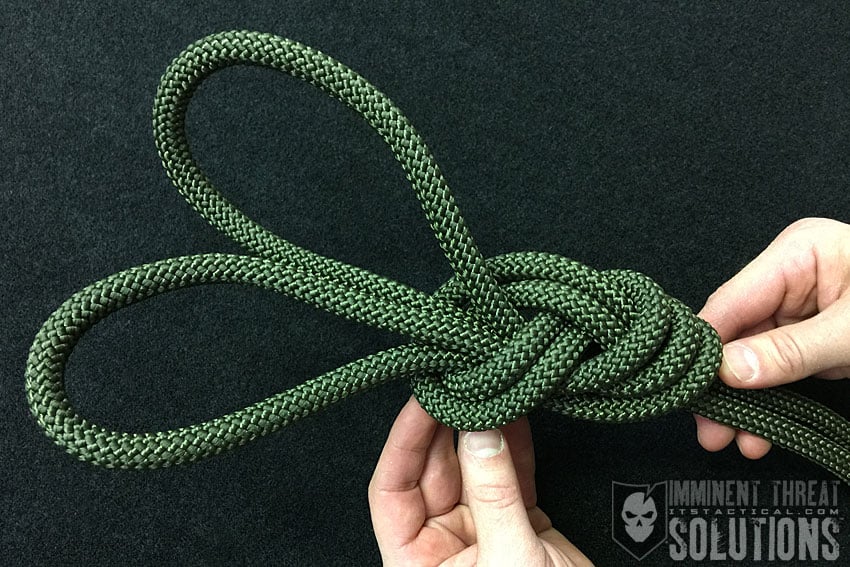
In this week’s continuing reintroduction of our Knot of the Week series shot in HD, I’ll be going through the Figure-Eight Bend and a slew of variations on one of the most well known climbing knots. We’ll first look at the standard Figure-Eight, talk about joining lines together with the Figure-Eight Bend, jump over to a Figure-Eight on a Bight, compare that with the Threaded Figure-Eight and lastly finish up talking about the Double Figure-Eight on a Bight.
The Figure-Eight is in my group of essentials when it comes to climbing knots and I’ve used many of these variations over and over again when climbing recreationally and as a BSA Certified Climbing Instructor for my son’s Boy Scout Troop. Remember that tying knots is a perishable skill that must be practiced until it becomes second nature.
Figure-Eight Knot » Bends
(Strength: 4/Security: 4/Stability: 3/Difficulty: 1) See below for what these ratings mean.
While the title and rating here is for joining two equal lines together with a Figure 8 bend, it doesn’t take into account the increased security gained with backing up each end.
The Figure-Eight Bend is used to join two lines of equal thickness and can be difficult to untie after being heavily loaded. The pattern created when tying the Figure-Eight gets its name from the “8” that’s made and makes a tied Figure-Eight easy to inspect to ensure it was done so correctly.
Uses for Figure-Eight and Variations
- Figure-Eight (Bend) – Join two equal lengths of rope together in a secure bend
- Figure-Eight on a Bight (Loop) – Creating a loop to connect to an anchor point or for nearly any usage like a lowering a pack, etc.
- Threaded Figure-Eight (Loop) – Tying into a Climbing Harness
- Double Figure-Eight on a Bight (Loop) – Securing a rope to a single anchor point, or equalizing loops between two anchor points
Figure-Eight on a Bight / Threaded Figure-Eight
The Figure-Eight on a Bight is ideal for tying into any point along a line to act as an anchor point. If it’s tied in the end of a rope you should always back it up. While this can be tied in the end of a rope, there’s a safety risk if clipping this into a harness via a carabiner during a Lead Climbing situation.
A carabiner can become cross-loaded in a fall and become twisted, producing a weak link. The shock can be caught by the gate of the carabiner, which carries a reduced strength. The kN (Kilo Newton) rating of a carabiner only holds true if the carabiner is loaded appropriately.
To avoid this issue and others associated with introducing a carabiner into the mix, use the Threaded Figure-Eight to tie directly into a harness. The Threaded Figure-Eight is also known as a Figure-Eight Follow-Through.
Note: The rope used in the video and photos above is BlueWater Ropes Assaultline Static Rope.
Double Figure-Eight on a Bight
Also known as the Super Eight, Canadian Eight, or Double-Loop Figure-Eight, the Double Figure-Eight on a Bight can be advantageous in situations that might call for the extra security of a second loop. It’s also easier to untie after being loaded when compared to the other variations of the Figure-Eight mentioned above.
This can be used to secure a rope to an anchor using both loops, or independently by adjusting each of the “bunny ears” to equalize between two anchor points. Don’t use a single loop, leaving the other unused. If any slipping occurs you could wind up with a melted rope due to the friction produced.
Ratings
Strength/Security/Stability/Difficulty
Each knot will be assigned a rating from 1-5 (1 representing the lowest score) based on the following four properties:
Strength – All knots will weaken the strength of a rope, however, there are knots that are stronger than others. The scale here will reflect how strong the rope remains with the specified knot.
Security – The security scale refers to how well the knot will stay tied, and resist coming loose under a normal load.
Stability – Stability refers to how easily the knot will come untied under an abnormal load (i.e. the knot being pulled in a direction it was not intended to) A lower score here represents instability.
Difficulty – The lower the number, the easier a knot is to tie.